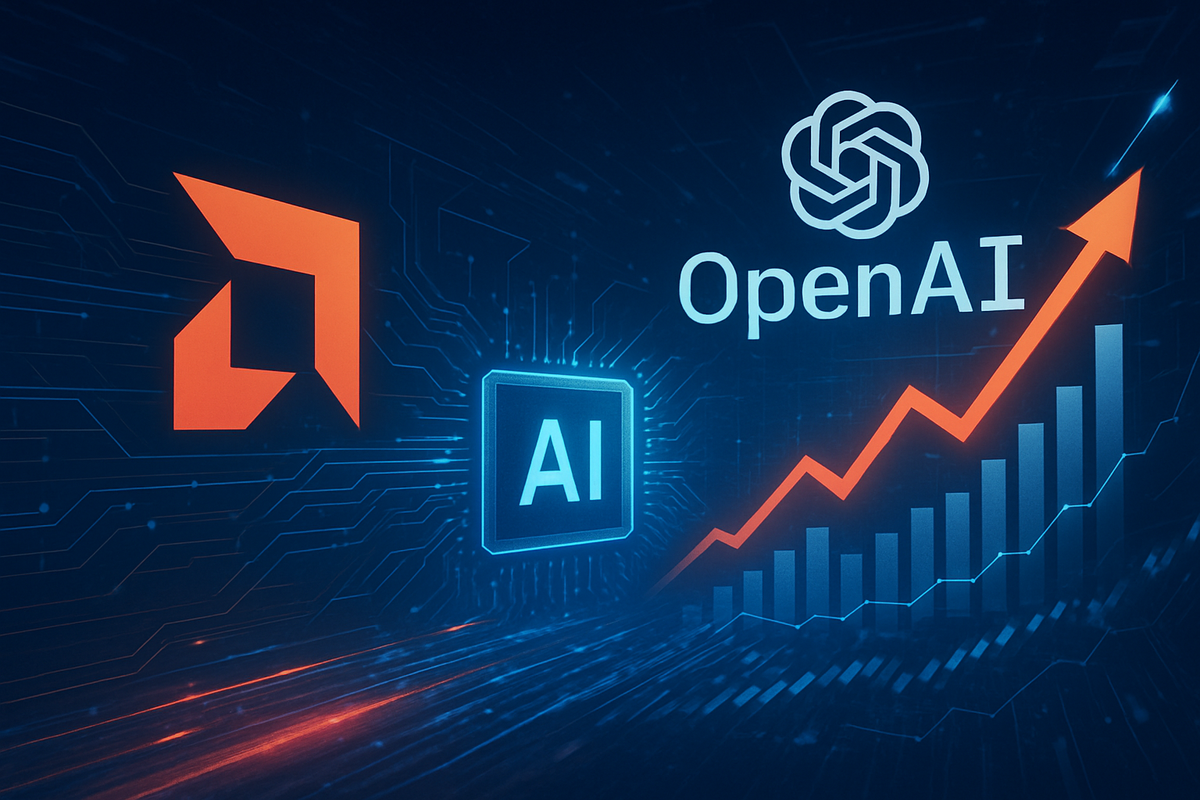
Advanced Micro Devices (NASDAQ: AMD) experienced an unprecedented stock surge on October 6, 2025, following the groundbreaking announcement of a multi-year AI chip deal with OpenAI. The partnership, which will see OpenAI deploy 6 gigawatts of AMD's Instinct GPUs, starting with the MI450 series, has sent shockwaves through the financial markets, adding approximately $80 billion to AMD's market capitalization and propelling its shares over 30% at market open. This landmark agreement not only validates AMD's aggressive push into the artificial intelligence sector but also signals a significant intensification of competition in the rapidly expanding AI chip market, long dominated by industry titan Nvidia (NASDAQ: NVDA).
The immediate implications are profound for both AMD and the broader tech landscape. For AMD, the deal represents a massive revenue opportunity, with projections of tens of billions annually and potentially exceeding $100 billion in new revenue over four years from OpenAI and other customers. It strategically positions the company as a formidable challenger in the AI infrastructure space. For the market, this alliance underscores the insatiable demand for high-performance AI compute and suggests a future where AI hardware supply is more diversified, potentially easing bottlenecks and fostering innovation across the ecosystem.
A New Era for AI Hardware: Unpacking the AMD-OpenAI Alliance
The strategic agreement between Advanced Micro Devices (NASDAQ: AMD) and OpenAI is a pivotal moment, marking a significant shift in the AI hardware landscape. OpenAI has committed to deploying 6 gigawatts of AMD's cutting-edge Instinct GPUs for its next-generation AI infrastructure. The rollout is set to commence with the MI450 series chips, with an initial 1 gigawatt deployment slated for the second half of 2026. This substantial commitment highlights OpenAI's confidence in AMD's capabilities to power its demanding AI models and services.
While the precise financial terms of the deal remain largely confidential, AMD has indicated that this partnership is expected to generate tens of billions of dollars in annual revenue, with potential new revenue streams from OpenAI and other customers exceeding $100 billion over a four-year period. A particularly notable element of the agreement is an option for OpenAI to acquire up to 10% of AMD's equity. This is structured through a warrant for up to 160 million shares, which will vest upon the achievement of specific technical and financial milestones, including AMD share price targets that escalate to $600 a share for the final installment. This equity component deeply aligns the long-term success of both entities.
The timeline leading up to this moment has been characterized by AMD's persistent investment in its Instinct GPU line and ROCm software platform, aiming to provide a credible alternative to Nvidia's CUDA ecosystem. OpenAI, on its part, has been actively seeking to diversify its hardware supply chain to support its ambitious AI development roadmap, which includes previous commitments from Nvidia. This deal follows a period of intense development and validation, culminating in OpenAI's decision to integrate AMD's solutions at scale. Key players involved are AMD CEO Lisa Su, who has spearheaded the company's AI strategy, and OpenAI CEO Sam Altman, whose vision for advanced AI necessitates robust and diverse computational resources.
Initial market reactions have been overwhelmingly positive for AMD. Its stock surged dramatically, jumping over 30% at market open and reaching a more than one-year high of $226.71. This added approximately $80 billion to its market capitalization and pushed AMD past Nvidia in year-to-date gains. While Nvidia's stock saw a modest dip, reflecting the increased competitive pressure, the overall sentiment is that this deal signifies a broader expansion of the AI infrastructure market, rather than a zero-sum game.
Winners and Losers: Reshaping the AI Chip Ecosystem
The monumental AI chip deal between Advanced Micro Devices (NASDAQ: AMD) and OpenAI is poised to redraw the lines of influence within the artificial intelligence hardware market, creating clear winners and presenting significant challenges for others. Unquestionably, Advanced Micro Devices (NASDAQ: AMD) emerges as the primary beneficiary. This deal not only injects a massive stream of revenue, projected to be tens of billions annually and over $100 billion over four years, but also provides a powerful validation of its Instinct GPU technology and ROCm software stack. The partnership elevates AMD's stature from a strong contender to a major player in the high-stakes AI accelerator market, solidifying its position as a critical supplier for leading AI developers. The equity warrant allowing OpenAI to acquire a stake further intertwines their destinies, suggesting a deep, long-term strategic alliance.
OpenAI, the pioneering force in generative AI, is also a significant winner. By diversifying its AI chip supply beyond a single vendor, it gains greater control over its infrastructure costs, reduces supply chain risks, and potentially accelerates its AI research and deployment timelines. This strategic move allows OpenAI to tap into AMD's innovative hardware, ensuring it has access to a broad spectrum of computational power necessary to train and run increasingly complex AI models. This partnership is crucial for OpenAI's ambitious plans to scale its AI capabilities and maintain its leadership in the rapidly evolving AI landscape.
On the other side, Nvidia (NASDAQ: NVDA), the long-reigning monarch of the AI chip market, faces new competitive pressures. While Nvidia's market dominance is far from over, and it continues to innovate and secure major deals, the AMD-OpenAI partnership signals a credible alternative is emerging. Nvidia's stock experienced a slight dip following the announcement, reflecting investor acknowledgment of increased competition. While Nvidia's CUDA ecosystem remains a powerful moat, AMD's gains could prompt a re-evaluation of market share projections and potentially influence pricing strategies in the future. Other smaller AI chip developers and startups might also find it harder to gain traction as the market consolidates around major players like AMD and Nvidia, though the overall expansion of the market could still offer niche opportunities.
Beyond the direct competitors, companies involved in AI infrastructure and data center construction stand to benefit. The commitment to deploy 6 gigawatts of GPUs signifies an immense build-out of data center capacity, translating into increased demand for servers, cooling systems, power infrastructure, and networking equipment. This could provide a tailwind for companies like Super Micro Computer (NASDAQ: SMCI) or Eaton (NYSE: ETN) that provide essential components and services for large-scale data center deployments. Conversely, companies that rely heavily on a single AI chip supplier might face challenges if that supplier's market share erodes or if they are unable to secure sufficient supply amidst heightened demand.
Broader Significance: Reshaping the AI Industrial Complex
The AMD-OpenAI deal transcends a mere commercial agreement; it represents a significant inflection point in the broader trajectory of the artificial intelligence industry. This event fits squarely into the overarching trend of an escalating "AI arms race," where technological supremacy is increasingly tied to computational power. As AI models grow exponentially in complexity and scale, the demand for specialized, high-performance accelerators has become insatiable. This partnership underscores the industry's collective effort to diversify its supply chain and reduce reliance on a single vendor, a critical strategic imperative given the geopolitical sensitivities and potential bottlenecks associated with advanced semiconductor manufacturing.
The ripple effects of this deal are far-reaching, extending to both competitors and partners. For competitors like Nvidia (NASDAQ: NVDA), it signals the emergence of a formidable rival capable of securing commitments from leading AI innovators. This could spur Nvidia to accelerate its own innovation cycles, potentially impacting pricing strategies and product roadmaps. For other chip designers and AI hardware startups, the deal serves as both a challenge and an inspiration, demonstrating that there is indeed a viable path to compete in this high-stakes arena, provided they can deliver cutting-edge performance and robust software ecosystems. Partners in the broader AI ecosystem, including cloud service providers and data center operators, will likely view this as an opportunity to offer more diverse hardware options to their clients, fostering a more competitive and innovative environment.
From a regulatory and policy perspective, this diversification could be welcomed by governments concerned about market concentration and supply chain resilience in critical technologies. A more competitive AI chip market might reduce antitrust concerns and encourage greater investment in domestic semiconductor capabilities. There are no immediate direct regulatory implications, but the increasing scale of AI infrastructure build-outs, particularly in terms of energy consumption (6 gigawatts is substantial), could draw scrutiny regarding environmental impact and energy policy in the longer term.
Historically, this event draws parallels to the early days of the PC revolution, where Intel (NASDAQ: INTC) dominated but eventually faced robust competition from AMD. More recently, it echoes the diversification seen in cloud computing, where major players like Amazon (NASDAQ: AMZN) and Google (NASDAQ: GOOGL) have increasingly developed their own custom silicon to optimize for specific workloads and reduce reliance on external vendors. The AMD-OpenAI partnership suggests that the AI industry is maturing to a point where custom or specialized hardware solutions, driven by strategic alliances, will become more common, moving beyond a single-vendor paradigm. This is not merely a chip deal; it's a foundational shift in how the AI industrial complex will be built and powered.
What Comes Next: Navigating the Future of AI Compute
The landmark deal between Advanced Micro Devices (NASDAQ: AMD) and OpenAI sets the stage for a dynamic future in the AI compute landscape, presenting both short-term adjustments and long-term strategic shifts. In the short term, the immediate focus will be on AMD's execution. The initial deployment of 1 gigawatt of MI450 series chips in the second half of 2026 will be a critical test of AMD's manufacturing capabilities, supply chain robustness, and the maturity of its ROCm software stack to meet OpenAI's rigorous demands. Successful deployment will further cement investor confidence and potentially lead to more partnerships. The market will closely watch AMD's quarterly earnings reports for updates on revenue recognition from this deal and any commentary on its AI pipeline.
Long-term possibilities are even more transformative. This partnership could catalyze a broader industry movement towards a multi-vendor AI hardware ecosystem, reducing the current over-reliance on Nvidia (NASDAQ: NVDA). It may encourage other major AI developers and cloud providers to explore AMD's offerings more aggressively, fostering greater competition and potentially driving down the cost of AI compute. The equity warrant component suggests a deep, ongoing collaboration that could extend to co-development of future AI hardware and software, creating a highly integrated and optimized solution for OpenAI's evolving needs. This could lead to AMD becoming a preferred, or even exclusive, partner for certain OpenAI initiatives.
Potential strategic pivots or adaptations will be required across the industry. AMD will need to continue investing heavily in its AI hardware and software, ensuring its Instinct platform remains competitive and developer-friendly. Nvidia, in response, may accelerate its own innovation, potentially by offering more customized solutions or strengthening its existing ecosystem through strategic acquisitions or partnerships. Other chip manufacturers might be prompted to intensify their efforts in the AI accelerator space, seeking to carve out their own niches. Cloud service providers will likely adapt their offerings to include a wider array of AMD-powered AI instances, catering to diverse customer demands.
Market opportunities or challenges will undoubtedly emerge. For AMD, the opportunity to capture significant market share in the rapidly expanding AI infrastructure market is immense. The challenge lies in scaling production, refining its software ecosystem, and consistently delivering performance that meets or exceeds expectations. For the broader market, increased competition could lead to faster innovation cycles and potentially more affordable AI compute, benefiting all AI developers. However, managing a multi-vendor hardware strategy can introduce complexity in terms of integration and optimization, a challenge that OpenAI will need to navigate effectively.
Potential scenarios and outcomes include AMD becoming a co-dominant player with Nvidia in the AI chip market, or a scenario where the market fragments further with specialized chips for different AI workloads. Another outcome could see AMD's success spurring a new wave of investment in open-source AI software and hardware development, further democratizing access to advanced AI capabilities. The future points towards a more diverse, competitive, and innovative landscape for AI compute, with AMD and OpenAI at the forefront of this evolution.
A New Dawn for AMD and the AI Market
The recent announcement of Advanced Micro Devices' (NASDAQ: AMD) multi-year AI chip deal with OpenAI marks a pivotal moment, not just for the companies involved, but for the entire artificial intelligence industry. The key takeaway is the emphatic validation of AMD's strategic pivot and substantial investment in its Instinct GPU line and ROCm software ecosystem. This deal unequivocally positions AMD as a major force in the high-stakes AI accelerator market, a domain previously dominated by Nvidia (NASDAQ: NVDA). The projected tens of billions in annual revenue and the significant stock surge underscore the market's belief in AMD's ability to execute and capitalize on the explosive demand for AI compute.
Moving forward, the assessment of the market suggests a shift towards a more diversified and competitive AI hardware landscape. OpenAI's decision to partner with AMD signals a strategic imperative among leading AI developers to reduce single-vendor reliance, mitigate supply chain risks, and foster innovation through broader hardware options. While Nvidia will undoubtedly remain a formidable player, this deal creates a credible alternative, potentially leading to more balanced market dynamics and accelerating the pace of technological advancement across the board. The sheer scale of the 6-gigawatt deployment also highlights the immense and ongoing build-out of AI infrastructure, indicating robust growth for the entire data center and semiconductor sectors.
Final thoughts on significance and lasting impact point to a future where AI computational power is not concentrated in the hands of a few, but rather supplied by a more diverse array of innovators. This fosters a healthier ecosystem, encouraging greater competition, potentially leading to more cost-effective solutions, and ultimately accelerating the development and deployment of advanced AI across various industries. The equity warrant component of the deal further solidifies a deep, long-term strategic alignment between AMD and OpenAI, suggesting a collaborative future that could redefine the benchmarks for AI performance and efficiency.
Investors should watch for several key indicators in the coming months. Foremost will be AMD's execution on the initial 1-gigawatt deployment in the second half of 2026, as well as any further details on the financial implications and revenue recognition from the OpenAI deal. Commentary from AMD's leadership regarding its AI roadmap, software development, and supply chain management will be crucial. Investors should also monitor Nvidia's response to this increased competition and the broader market's reaction to the evolving AI chip landscape. The performance of other AI infrastructure providers and cloud companies will also offer insights into the overall health and direction of the AI industrial complex.
This content is intended for informational purposes only and is not financial advice





